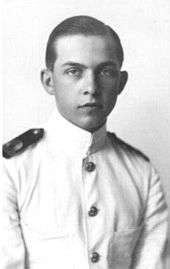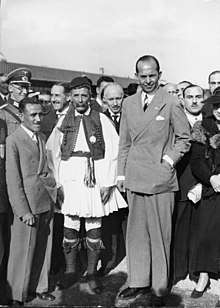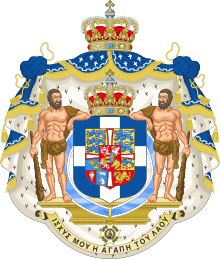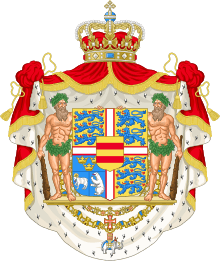Paul of Greece
| Paul | |
|---|---|
 King Paul during his reign | |
| King of the Hellenes | |
| Reign | 1 April 1947 – 6 March 1964 |
| Predecessor | George II |
| Successor | Constantine II |
| Prime Ministers |
See list
|
| Born |
14 December 1901 Tatoi Palace, Athens, Kingdom of Greece |
| Died |
6 March 1964 (aged 62) Athens, Greece |
| Burial |
12 March 1964 Royal Cemetery, Tatoi Palace, Greece |
| Spouse | |
| Issue | |
| House | Glücksburg |
| Father | Constantine I of Greece |
| Mother | Sophia of Prussia |
| Signature |
 |
Paul (Greek: Παύλος, Pávlos; 14 December 1901 – 6 March 1964) was King of Greece from 1947 until his death in 1964.
Early life

Paul was born at Tatoi Palace in Athens, the third son of King Constantine I of Greece and his wife, Princess Sophia of Prussia. He trained as an army officer at the Royal Military College, Sandhurst and later at the Hellenic Military Academy in Kypseli, Athens. Paul was an army officer cadet in the Coldstream Guards and Lieutenant with the Evzones.
From 1917 to 1920, Paul lived in exile with his father, Constantine I. From 1923 to 1935, he lived in exile again in England, this time with his brother, George II. He worked briefly in an aircraft factory under an alias, and through Viscount Tredegar met and befriended notorious literary muse Denham Fouts, who later alleged an affair.[1] However, Fouts's friend John B. L. Goodwin said Fouts often made up stories about his life,[2] and literary critic Katherine Bucknell thought many of the tales about him were myth.[3]
| Styles of King Paul of the Hellenes | |
|---|---|
|
| |
| Reference style | His Majesty |
| Spoken style | Your Majesty |
Marriage and children

On 9 January 1938, Paul married Princess Frederica of Hanover, his first cousin once removed through Frederick III, German Emperor, and Victoria, Princess Royal, and second cousin through Christian IX of Denmark, at Athens. They had three children:
- Sophia, Queen of Spain (born 1938).
- Constantine II, King of the Hellenes (born 1940).
- Princess Irene of Greece and Denmark (born 1942).
World War II
During most of World War II, from 1941 to 1946, when Greece was under German occupation, Paul was with the Greek government-in-exile in London and Cairo. From Cairo, he broadcast messages to the Greek people.
Reign
Paul returned to Greece in 1946. He succeeded to the throne in 1947, on the death of his childless elder brother, King George II, during the Greek Civil War (between Greek Communists and the non-communist Greek government). In 1947 he was unable to attend the wedding of his first cousin, Prince Philip, Duke of Edinburgh to the future Queen Elizabeth II of the United Kingdom as he was suffering from typhoid fever.[4]
By 1949 the Civil War was effectively over, with the Communist insurgents ceasing the majority of their operations, and the task of rebuilding the shattered north of the country began.[5]
In the 1950s Greece recovered economically, and diplomatic and trade links were strengthened by Paul’s state visits abroad. He became the first Greek Monarch to visit a Turkish Head of State. However, links with Britain became strained over Cyprus, where the majority Greek population favored union with Greece, which Britain, as the colonial power, would not endorse. Eventually, Cyprus became an independent state in 1960.[6]
In December 1959, Prince Maximillian of Bavaria presented King Otto's coronation regalia to King Paul. It had been almost a century since they were last in Greece.
Meanwhile, republican sentiment was growing in Greece. Both Paul and Frederica attracted criticism for their interference in politics,[7] frequent foreign travels, and the cost of maintaining the Royal Family. Paul responded by economising and donated his private estate at Polidendri to the State.[8]
In 1959, he had an operation for a cataract, and in 1963 an emergency operation for appendicitis. In late February 1964, he underwent a further operation for stomach cancer, and died about a week later in Athens.[9] He was succeeded by his son, Constantine II.
Legacy
In March 2014, a memorial service took place at Tatoi Palace in Athens commemorating the fiftieth anniversary of Paul's death. Members of the Greek and Spanish royal families were present.[10][11]
Ancestry
Notes and sources
| Wikimedia Commons has media related to Paul I of Greece. |
- ↑ Vanderbilt, p. 30; Wishart, p. 52
- ↑ Clarke, p. 172
- ↑ Bucknell, p. 941
- ↑ Van der Kiste, p. 177
- ↑ Van der Kiste, p. 179
- ↑ Van der Kiste, p. 180
- ↑ Clogg, p. 153; Woodhouse, p. 283
- ↑ Van der Kiste, pp. 182–183
- ↑ Van der Kiste, pp. 183–184
- ↑ "GRC: Greece and Spanish Royal Families Attend Commemorative Mass For King Paul I of Greece Pictures & News Photos | Getty Images". gettyimages.co.uk. Retrieved 4 September 2015.
- ↑ "Spanish and Greek royals come together in Athens to remember King Paul I of Greece". Hello Magazine.
References
- Bucknell, Katherine (1996). Christopher Isherwood Diaries: Volume One 1939–1960 London: Methuen. ISBN 0-413-69680-4
- Clarke, Gerald (1988). Capote: A Biography. London: Hamish Hamilton. ISBN 0-241-12549-9
- Clogg, Richard (1992). A Concise History of Greece, Cambridge University Press
- Vanderbilt, Arthur (2014). Best-Kept Boy in the World: The Life and Loves of Denny Fouts. Magnus Books
- Van der Kiste, John (1994). Kings of the Hellenes. Stroud, Gloucestershire: Alan Sutton Publishing. ISBN 0-7509-0525-5
- Wishart, Michael (1977). High Diver. Blond and Briggs
- Woodhouse, C.M. (1998). Modern Greece: A Short History, Mackays of Chatham, Kent
External links
- Newspaper clippings about Paul of Greece in the 20th Century Press Archives of the German National Library of Economics (ZBW)
Paul of Greece Cadet branch of the House of Oldenburg Born: 14 December 1901 Died: 6 March 1964 | ||
| Regnal titles | ||
|---|---|---|
| Preceded by George II |
King of the Hellenes 1 April 1947 – 6 March 1964 |
Succeeded by Constantine II |
.svg.png)

